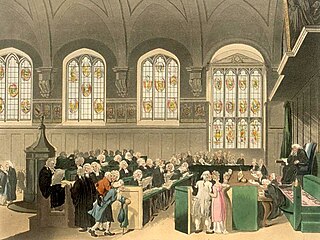Judgment
Held, damages were awarded.
| | This section needs expansion. You can help by adding to it. (February 2015) |
| Shepton v Dogge | |
|---|---|
| Citation | (1442) B&M 390 |
| Keywords | |
| Contract, remedies | |
Shepton v Dogge (1442) B&M 390 [1] is an old English contract law case, concerning the action for debt, and exemplifying the manner in which litigants had to make claims in deceit, or other forms of action that were recognised by the primitive legal system.
The defendant agreed, in London, to sell and convey land outside London to the plaintiff. She took the money, but then conveyed the land to a third party. The plaintiff sued in deceit. Had the land been inside the city, the action could have been brought in city courts by London’s custom. This would have meant actions in covenant did not require documents under a seal. The normal remedy would be specific performance. Moreover, if one had put it out of their power to perform, they would be imprisoned until they could repay.
Held, damages were awarded.
| | This section needs expansion. You can help by adding to it. (February 2015) |
At common law, damages are a remedy in the form of a monetary award to be paid to a claimant as compensation for loss or injury. To warrant the award, the claimant must show that a breach of duty has caused foreseeable loss. To be recognized at law, the loss must involve damage to property, or mental or physical injury; pure economic loss is rarely recognized for the award of damages.

Roman law is the legal system of ancient Rome, including the legal developments spanning over a thousand years of jurisprudence, from the Twelve Tables, to the Corpus Juris Civilis ordered by Eastern Roman emperor Justinian I. Roman law forms the basic framework for civil law, the most widely used legal system today, and the terms are sometimes used synonymously. The historical importance of Roman law is reflected by the continued use of Latin legal terminology in many legal systems influenced by it, including common law.

Estoppel is a judicial device in common law legal systems whereby a court may prevent or "estop" a person from making assertions or from going back on their word; the person so prevented is said to be "estopped". Estoppel may prevent someone from bringing a particular claim. Legal doctrines of estoppel are based in both common law and equity. Estoppel is also a concept in international law.
In property law, title is an intangible construct representing a bundle of rights in (to) a piece of property in which a party may own either a legal interest or equitable interest. The rights in the bundle may be separated and held by different parties. It may also refer to a formal document, such as a deed, that serves as evidence of ownership. Conveyance of the document may be required in order to transfer ownership in the property to another person. Title is distinct from possession, a right that often accompanies ownership but is not necessarily sufficient to prove it. In many cases, possession and title may each be transferred independently of the other. For real property, land registration and recording provide public notice of ownership information.
The forms of action were the different procedures by which a legal claim could be made during much of the history of the English common law. Depending on the court, a plaintiff would purchase a writ in Chancery which would set in motion a series of events eventually leading to a trial in one of the medieval common law courts. Each writ entailed a different set of procedures and remedies which together amounted to the "form of action".
Restitution and unjust enrichment is the field of law relating to gains-based recovery. In contrast with damages, restitution is a claim or remedy requiring a defendant to give up benefits wrongfully obtained. Liability for restitution is primarily governed by the "principle of unjust enrichment": A person who has been unjustly enriched at the expense of another is required to make restitution.
Assumpsit, or more fully, action in assumpsit, was a form of action at common law used to enforce what are now called obligations arising in tort and contract; and in some common law jurisdictions, unjust enrichment. The origins of the action can be traced to the 14th century, when litigants seeking justice in the royal courts turned from the writs of covenant and debt to the trespass on the case.
In common law jurisdictions, a misrepresentation is a false or misleading statement of fact made during negotiations by one party to another, the statement then inducing that other party to enter into a contract. The misled party may normally rescind the contract, and sometimes may be awarded damages as well.
In all lawsuits involving conflict of laws, questions of procedure as opposed to substance are always determined by the lex fori, i.e. the law of the state in which the case is being litigated.
Conflict of laws in the United States is the field of procedural law dealing with choice of law rules when a legal action implicates the substantive laws of more than one jurisdiction and a court must determine which law is most appropriate to resolve the action. In the United States, the rules governing these matters have diverged from the traditional rules applied internationally. The outcome of this process may require a court in one jurisdiction to apply the law of a different jurisdiction.
Ex turpi causa non oritur actio is a legal doctrine which states that a plaintiff will be unable to pursue legal relief and damages if it arises in connection with their own tortious act. The corresponding Ex turpe causa non oritur damnum, "From a dishonourable cause, no damage arises" is a similar construction. Particularly relevant in the law of contract, tort and trusts, ex turpi causa is also known as the illegality defence, since a defendant may plead that even though, for instance, he broke a contract, conducted himself negligently or broke an equitable duty, nevertheless a claimant by reason of his own illegality cannot sue. The UK Supreme Court provided a thorough reconsideration of the doctrine in 2016 in Patel v Mirza.

Smith v Hughes (1871) LR 6 QB 597 is an English contract law case. In it, Blackburn J set out his classic statement of the objective interpretation of people's conduct when entering into a contract. The case regarded a mistake made by Mr. Hughes, a horse trainer, who bought a quantity of oats that were the same as a sample he had been shown. However, Hughes had misidentified the kind of oats: his horse could not eat them, and he refused to pay for them. Smith, the oat supplier, sued for Hughes to complete the sale as agreed. The court sided with Smith, as he provided the oats Hughes agreed to buy. That Hughes made a mistake was his own fault, as he had not been misled by Smith. Since Smith had made no fault, there was no mutual mistake, and the sale contract was still valid.

Addis v Gramophone Co Ltd [1909] AC 488 is an old English contract law and UK labour law case, which used to restrict damages for non-pecuniary losses for breach of contract.

Williams v Natural Life Health Foods Ltd[1998] UKHL 17 is an important English tort law, company law and contract law case. It held that for there to be an effective assumption of responsibility, there must be some direct or indirect conveyance that a director had done so, and that a claimant had relied on the information. Otherwise only a company itself, as a separate legal person, would be liable for negligent information.

Crabb v Arun District Council [1975] EWCA Civ 7 is a leading English land law and contract case concerning "proprietary estoppel". Lord Denning MR affirmed that where agreements concern the acquisition of rights over land, there is no need for both parties to provide a consideration for upholding the bargain. While promissory estoppel cannot found a cause of action it was held that in the peculiar situation of land, consideration is not necessary at all.

Gordon v Selico (1986) 18 H.L.R. 219 is an English contract law on the subject of misrepresentation by action. It was held that positive actions - in this case, the concealment of dry rot - could amount to operative misrepresentations.

City of London Building Society v Flegg[1987] UKHL 6 is an English land law case decided in the House of Lords on the relationship between potential overriding interests and the concept of overreaching.

Slade's Case was a case in English contract law that ran from 1596 to 1602. Under the medieval common law, claims seeking the repayment of a debt or other matters could only be pursued through a writ of debt in the Court of Common Pleas, a problematic and archaic process. By 1558 the lawyers had succeeded in creating another method, enforced by the Court of King's Bench, through the action of assumpsit, which was technically for deceit. The legal fiction used was that by failing to pay after promising to do so, a defendant had committed deceit, and was liable to the plaintiff. The conservative Common Pleas, through the appellate court the Court of Exchequer Chamber, began to overrule decisions made by the King's Bench on assumpsit, causing friction between the courts.
The history of contract law dates back to ancient civilizations and the development of contract law has been heavily influenced by Ancient Greek and Roman thought. There have been further significant developments in contract law during and since the Middle Ages and especially with the development of global trade.

Taltarum's Case is the name given to an English legal case heard in the Court of Common Pleas, with decisions being handed down in 1465 and 1472. The case was long thought to have established the operation of the common recovery, a collusive legal procedure that was, until finally abolished in 1833, an important element of English law of real property. By means of a complex legal fiction, a recovery converted a freehold or copyhold property held in fee tail, which could not be freely sold or disposed of, into an estate in fee simple, which could be disposed without restriction.